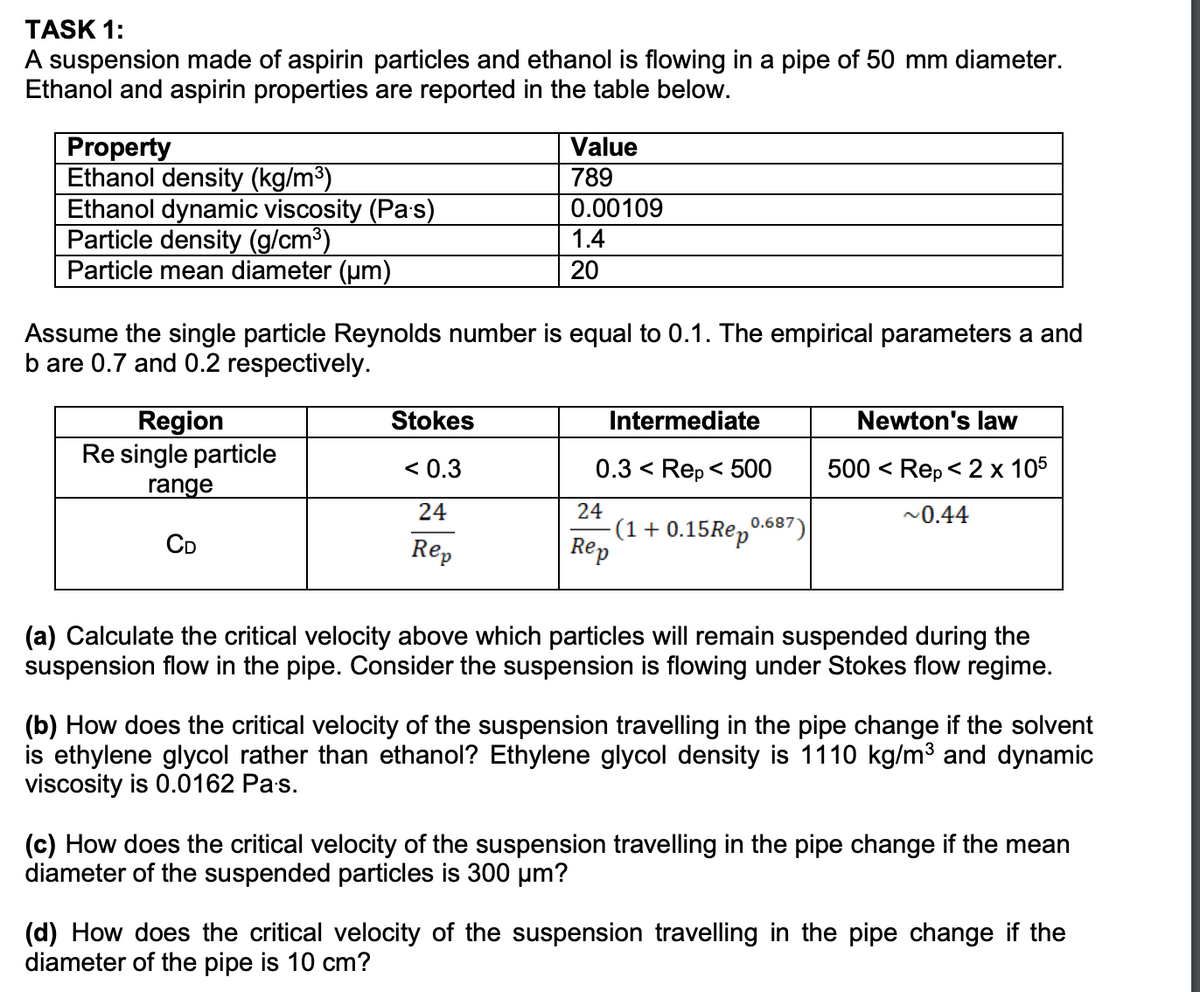A suspension made of aspirin particles and ethanol is flowing in a pipe of 50 mm diameter. Ethanol and aspirin properties are reported in the table below. Property Ethanol density (kg/m³) Ethanol dynamic viscosity (Pas) Particle density (g/cm³) Particle mean diameter (µm) Region Re single particle range CD Value 789 0.00109 Assume the single particle Reynolds number is equal to 0.1. The empirical parameters a and b are 0.7 and 0.2 respectively. Stokes < 0.3 24 Rep 1.4 20 Intermediate 0.3< Rep < 500 24 Rep (1 + 0.15 Rep 0.687) Newton's law 500 Rep < 2 x 105 ~0.44 (a) Calculate the critical velocity above which particles will remain suspended during the suspension flow in the pipe. Consider the suspension is flowing under Stokes flow regime. (b) How does the critical velocity of the suspension travelling in the pipe change if the solvent is ethylene glycol rather than ethanol? Ethylene glycol density is 1110 kg/m³ and dynamic viscosity is 0.0162 Pa.s. (c) How does the critical velocity of the suspension travelling in the pipe change if the mean diameter of the suspended particles is 300 μm? (d) How does the critical velocity of the suspension travelling in the pipe change if the diameter of the pipe is 10 cm?
A suspension made of aspirin particles and ethanol is flowing in a pipe of 50 mm diameter. Ethanol and aspirin properties are reported in the table below. Property Ethanol density (kg/m³) Ethanol dynamic viscosity (Pas) Particle density (g/cm³) Particle mean diameter (µm) Region Re single particle range CD Value 789 0.00109 Assume the single particle Reynolds number is equal to 0.1. The empirical parameters a and b are 0.7 and 0.2 respectively. Stokes < 0.3 24 Rep 1.4 20 Intermediate 0.3< Rep < 500 24 Rep (1 + 0.15 Rep 0.687) Newton's law 500 Rep < 2 x 105 ~0.44 (a) Calculate the critical velocity above which particles will remain suspended during the suspension flow in the pipe. Consider the suspension is flowing under Stokes flow regime. (b) How does the critical velocity of the suspension travelling in the pipe change if the solvent is ethylene glycol rather than ethanol? Ethylene glycol density is 1110 kg/m³ and dynamic viscosity is 0.0162 Pa.s. (c) How does the critical velocity of the suspension travelling in the pipe change if the mean diameter of the suspended particles is 300 μm? (d) How does the critical velocity of the suspension travelling in the pipe change if the diameter of the pipe is 10 cm?
Principles of Heat Transfer (Activate Learning with these NEW titles from Engineering!)
8th Edition
ISBN:9781305387102
Author:Kreith, Frank; Manglik, Raj M.
Publisher:Kreith, Frank; Manglik, Raj M.
Chapter5: Analysis Of Convection Heat Transfer
Section: Chapter Questions
Problem 5.18P: The drag on an airplane wing in flight is known to be a function of the density of air (), the...
Related questions
Question
ANSWERS
W6/T1 (a) 0.23 m/s (b) 0.13 m/s (c) 1.16 m/s (d) 0.22 m/s
show working how to reach these please

Transcribed Image Text:TASK 1:
A suspension made of aspirin particles and ethanol is flowing in a pipe of 50 mm diameter.
Ethanol and aspirin properties are reported in the table below.
Property
Ethanol density (kg/m³)
Ethanol dynamic viscosity (Pas)
Particle density (g/cm³)
Particle mean diameter (um)
Region
Re single particle
range
Assume the single particle Reynolds number is equal to 0.1. The empirical parameters a and
b are 0.7 and 0.2 respectively.
CD
Value
789
0.00109
Stokes
< 0.3
24
Rep
1.4
20
Intermediate
0.3 < Rep < 500
24
Rep
(1 + 0.15 Rep 0.687)
Newton's law
500 <
Rep < 2 x 105
~0.44
(a) Calculate the critical velocity above which particles will remain suspended during the
suspension flow in the pipe. Consider the suspension is flowing under Stokes flow regime.
(b) How does the critical velocity of the suspension travelling in the pipe change if the solvent
is ethylene glycol rather than ethanol? Ethylene glycol density is 1110 kg/m³ and dynamic
viscosity is 0.0162 Pa.s.
(c) How does the critical velocity of the suspension travelling in the pipe change if the mean
diameter of the suspended particles is 300 μm?
(d) How does the critical velocity of the suspension travelling in the pipe change if the
diameter of the pipe is 10 cm?
![Critical velocity:
Archimedes number:
F (when Ar > 80):
F (when Ar < 80):
F√ √GD (2-1)
Vc = FgD
4 3
Ar = 1 x ³ pf (Ps - Pf) - /2/2
F = a Arb
F = √² [2 + 0.3 log₁0 (x)]
Unhindered settling, single particle velocity: vs
=
g(Ps-Pf)x²
18μ](/v2/_next/image?url=https%3A%2F%2Fcontent.bartleby.com%2Fqna-images%2Fquestion%2Fde55ad6b-27eb-44c5-bca1-afdb32f2dfc7%2Fd9b2d021-accb-4fc4-b809-9a2d7028383a%2F9snb4kn_processed.png&w=3840&q=75)
Transcribed Image Text:Critical velocity:
Archimedes number:
F (when Ar > 80):
F (when Ar < 80):
F√ √GD (2-1)
Vc = FgD
4 3
Ar = 1 x ³ pf (Ps - Pf) - /2/2
F = a Arb
F = √² [2 + 0.3 log₁0 (x)]
Unhindered settling, single particle velocity: vs
=
g(Ps-Pf)x²
18μ
Expert Solution
This question has been solved!
Explore an expertly crafted, step-by-step solution for a thorough understanding of key concepts.
Step by step
Solved in 4 steps with 3 images

Knowledge Booster
Learn more about
Need a deep-dive on the concept behind this application? Look no further. Learn more about this topic, mechanical-engineering and related others by exploring similar questions and additional content below.Recommended textbooks for you

Principles of Heat Transfer (Activate Learning wi…
Mechanical Engineering
ISBN:
9781305387102
Author:
Kreith, Frank; Manglik, Raj M.
Publisher:
Cengage Learning

Principles of Heat Transfer (Activate Learning wi…
Mechanical Engineering
ISBN:
9781305387102
Author:
Kreith, Frank; Manglik, Raj M.
Publisher:
Cengage Learning